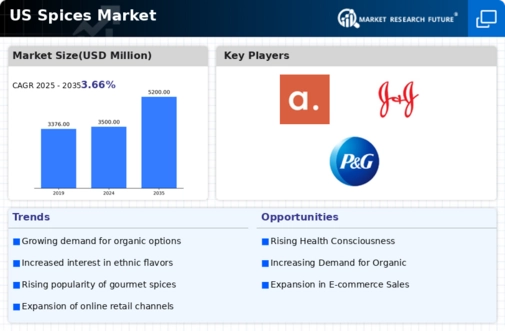Rising Demand for Organic Spices
The spices market in the US is experiencing a notable shift towards organic products. Consumers are increasingly prioritizing health-conscious choices, leading to a surge in demand for organic spices. According to recent data, the organic spices segment is projected to grow at a CAGR of approximately 8% over the next five years. This trend is driven by a growing awareness of the benefits of organic farming practices, which are perceived to be more sustainable and healthier. As a result, retailers are expanding their organic offerings, which is likely to enhance the overall growth of the spices market. The increasing availability of organic spices in both brick-and-mortar stores and online platforms further supports this trend, indicating a robust future for organic products within the spices market.
Growth of the Food Service Sector
The food service sector in the US is witnessing robust growth, which is positively impacting the spices market. As restaurants and catering services expand, the demand for a variety of spices to enhance flavor profiles is increasing. Recent statistics indicate that the food service industry is projected to grow by approximately 6% annually over the next few years. This growth is likely to drive higher consumption of spices, as food service providers seek to differentiate their offerings through unique flavors. Consequently, suppliers in the spices market are expected to benefit from this trend, as they cater to the evolving needs of the food service sector, thereby contributing to overall market expansion.
Culinary Innovation and Experimentation
Culinary innovation is a significant driver in the spices market, as chefs and home cooks alike seek to experiment with new flavors and combinations. The rise of cooking shows and social media platforms has inspired consumers to explore diverse cuisines, leading to an increased interest in unique spice blends. This trend is reflected in the growing sales of specialty spices, which have seen an increase of around 15% in recent years. As consumers become more adventurous in their cooking, the demand for exotic spices and blends is likely to continue to rise. This shift not only enhances the culinary landscape but also contributes to the overall expansion of the spices market, as manufacturers respond by introducing innovative products that cater to evolving consumer preferences.
Increased Focus on Food Safety and Quality
Food safety and quality have become paramount concerns for consumers in the spices market. With rising awareness of foodborne illnesses and contamination, consumers are demanding higher standards for the spices they purchase. Regulatory bodies are also tightening safety regulations, which compels manufacturers to adopt stringent quality control measures. This focus on safety is likely to drive investments in better processing technologies and supply chain transparency. As a result, companies that prioritize quality and safety are expected to gain a competitive edge in the spices market. The emphasis on traceability and quality assurance may also lead to increased consumer trust, further propelling market growth.
Sustainability and Ethical Sourcing Trends
Sustainability and ethical sourcing are becoming increasingly important in the spices market. Consumers are more inclined to support brands that demonstrate a commitment to sustainable practices and fair trade. This shift is prompting companies to adopt environmentally friendly sourcing methods and transparent supply chains. Recent surveys indicate that nearly 70% of consumers are willing to pay a premium for sustainably sourced products. As a result, businesses that prioritize sustainability are likely to attract a loyal customer base, which can significantly enhance their market position. This trend not only aligns with consumer values but also contributes to the long-term viability of the spices market, as it encourages responsible practices throughout the supply chain.














Leave a Comment